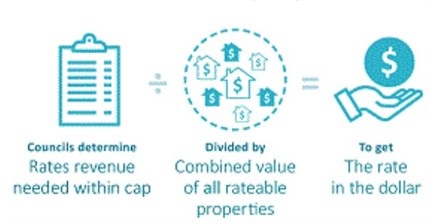The rate cap is announced by the Minister for Local Government in December of each year for the following financial year.
Councillors and officers review costs, expenditure and needs of Council and determine whether an application needs to be made to the Essential Services Commission to increase rates above the rate cap. Since the introduction in 2016, Council has not sought to increase rates above the rate cap.
The rate increase is then applied to the previous year’s rates to determine the general rates for the new financial year. This is then divided by the combined value of all rateable properties to get the rate in the dollar as depicted in the image below.

General rates are added to any municipal and garbage charges set by a council and the Fire Service Levy to determine the total rates payable on a property.
Rising property values usually result in the adjustment by Council of a lower rate in the dollar to offset the overall increase in property values.
Councils don't collect extra rate revenue as a result of a revaluation. A revaluation does not increase the total amount of money a Council collects in rates — it redistributes the amount of rates payable by individual properties.